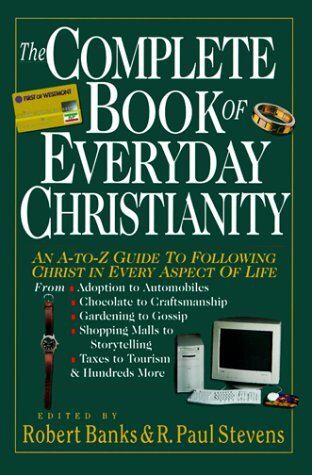Shopping
Book / Produced by partner of TOW
Shopping has become the main activity for most people outside the home and workplace. This is a relatively recent phenomenon. In previous centuries, those at the top of the social pyramid were often engaged in what social critic Thorstein Veblen called “conspicuous consumption.” But mass materialism became possible only in the wake of the Industrial Revolution and secularization.
The Rise of the Consumer Culture
For the consumer culture to arise, however, two other developments were necessary. One was the emergence of the mass media and their offspring, advertising. This provided the means for the wide-scale marketing of goods. The other development was the appearance of the therapeutic personality, defined according to unsatisfied needs and the desire for self-fulfillment. Previously, especially in Protestant countries, life revolved around personal self-denial in favor of a commitment to work and thrift, family and civic obligations. It was only when the external enticements of advertising connected with inner longings for physical and material well-being that the shift to a more individual, leisure-oriented, consumer culture took place. At the heart of this was the shopping mentality.
It was in newer Western societies, particularly the United States, that the consumer culture took root. One sign of this was the commercial co-option of the main annual celebrations of American Christianity—Easter, Christmas, Thanksgiving and even Mother’s Day—in the last quarter of the nineteenth and first quarter of the twentieth century. Another was the growth of increasingly large retail centers, from the department store to the shopping mall. A further indication of this was the proliferation of road signs and billboards, catalogs and junk mail that have increasingly blanketed the country and filled mailboxes. The latest development is the appearance of home shopping TV channels and shopping by computer. While its members succumb to many of these developments, the church as a whole body has increasingly turned itself into a marketing agency, advertising a shopping mall of religious services and meetings. Even God is often treated as a giant vending machine for religious consumption.
On average, Americans now spend about six hours a week in shopping-related activities, or around 6 percent of their waking hours. This is about 20 percent higher than twenty years ago. During that time, Sunday shopping has almost doubled and expenditure on consumer items has increased almost 50 percent in real dollar terms. While women devote more time to shopping than men, the difference amounts to only two hours a week. Better-educated people tend to shop more than others, though on the whole those with higher incomes do not spend more time shopping than those with lower ones. About half of people’s shopping time goes toward buying groceries, clothing and other basic articles.
The Shopping Mentality
The spread of the consumer society has resulted in several noticeable changes in people’s attitudes toward shopping.
As advertising becomes ever more sophisticated, we are more open to being manipulated and exploited by it. Advertisers imaginatively and emotionally cater to people’s insecurities and lack of self-confidence. Particularly susceptible are the young and the housebound, and women more than men. Advertisers are also extremely successful in creating new needs and in stimulating envy. But we cannot lay the whole blame on advertisers. Many people today go shopping partly to advertise themselves—to be seen by other shoppers and use their reactions as feedback for deciding whether they need to dress differently or have additional accouterments. All this helps create the consumer personality and the “shop till you drop” mentality.
Many people today rely on what they buy for telling them who they are or defining what they want to be. They look to shopping not just to get necessities or to feel pleasure, but to give them identity and meaning. It is a case of “I shop, therefore I am.” When feeling down about themselves or deciding to try to become someone different, they become prey to believing that buying new clothes, getting a new hairstyle or purchasing a new car will somehow miraculously bring this about. The attraction of the new is central here. Underlying this is often the desire to forge a whole new identity for themselves. Window-shopping provides literal “models” to look at. The way others are outfitted or housed supplies other models, as does the lifestyle of media, sports and fashion celebrities.
Shopping also appeals to certain quasi-religious longings. The experience can give a brief, if limited, sense of transcendence by helping people to “get out of themselves” and enter a different, almost magical, world. Shopping malls in particular seek to stimulate this through their expansive designs, exotic colors, lofty ceilings and uplifting music. The quest for bargains also promises people the experience of a kind of material “grace.” What could be more exciting than discovering something you really want that hardly costs anything? For some this is a reflection or substitute, however pale, for experiencing God’s free offer of the gospel. Unfortunately it is one that never fully satisfies, for we cannot buy an identity or a purpose, intimacy or happiness. Trying to do this only leaves us at the mercy of promises of more, better and newer versions of the same.
In these ways we have moved from being citizens to primarily consumers. This contains the risk that people themselves will become commodities to be bought by advertising, and sometimes even sold off through the sale of mailing lists. Like all commodities, from the point of view of the economist, producer, advertiser or salesperson, they are interchangeable, just numbers on a sales chart. In other cases people become compulsive or pathological spenders. For some women especially, shopping becomes a mood-elevating drug that feeds their poor self-image, makes them feel good and beautiful or restores a sense of excitement to their lives. This is a form of addiction as powerful as dependence on alcohol or a chemical substance.
A Christian Perspective on Purchasing
How can we go shopping Christianly? In the first instance we should realize that we are not the first to search for a less material lifestyle. Others have traveled this route before, especially in the monastic tradition, early Anabaptist communities, the Quakers and Puritans, and most recently the Christian counterculture. All these people thought carefully about what, how much and when to buy, possess and consume.
The Bible also provides us with some basic perspectives. We need to remind ourselves that already, through Christ, we have been “bought at a price” (1 Cor. 6:20), and therefore we do not have to buy our way to fullness of life. The model we should primarily seek to imitate is nothing less than Christ. As the Spirit transforms us into his image we become a “new creation,” have a new identity and find a new direction. We should basically be content with whatever we have, knowing that God will at times lavish good things on us and at other times we may experience want (Phil. 4:11). We ought to remember that since the form of this world is passing away, we should “buy something as if it were not [ours] to keep” (1 Cor. 7:30). Indeed, freely giving away a generous proportion of what we earn is a responsibility (2 Cor. 9:7-9). It is also important that we look to the Spirit to develop within us self-control, one of the prime fruits of the Spirit. If we “lack wisdom” in this or any other area, we are invited to ask God sincerely for it (James 1:5).
What follow are some general principles for resisting the consumer culture, refusing to be conned by manipulative advertising and distancing oneself from a consumer approach to life. These are designed to help us travel in this world more lightly as resident aliens, whose prime loyalty belongs to a “better country” (Hebrews 11:13-16). First, as a family or with other single friends or with your small group in the church, begin to discuss the relationship between shopping and discipleship. Through newspapers, magazines and books, investigate the facts about overconsumption and poverty in your country and locality. Where you can do so reasonably and in a nonpressured way, make and grow things yourself rather than always being dependent on buying them. Collate your shopping trips into one or two a week, and where possible buy cooperatively rather than just for your individual or household needs. Discover places where prices are lower and packaging less wasteful. List specifically and budget carefully what you will buy, and resist the temptation to engage in impulse buying.
Many have found the following practical questions helpful in their shopping. If items are more than a certain price, ask the following questions:
Why do you want the item, and are your reasons for doing so adequate?
Do you have the budget to cover the cost, or will you have to put too much on credit?
Can you do without it, and what would you do with the money if you didn’t spend it this way?
Would you be able to make the item, or would it be enough to get it secondhand?
Do you need it now, or can it wait until you will use it more often?
Have you, or those for whom you are buying it, made use of similar items already owned, or are you simply piling up items which will be little used?
Can you borrow it or buy it with others so that several share a little-used, expensive product?
If it is replacing something, do you have to replace it yet, or can you wait until it is worn out or broken?
Is it fixable if it breaks, and is there an accessible, trustworthy repair center with reasonable prices?
How much will it damage God’s world, either by consuming scarce resources or by becoming nondisposable waste?
For those who are prey to impulse buying and overspending, here are further concrete suggestions about how to go shopping:
Don’t go shopping unless you have something specific in mind to buy.
Go to the mall only with a definite purchase or fixed amount of money in mind.
Wear a watch or place a time limit on how long you can “afford” to stay or shop.
Take someone else with you, but not a person similarly vulnerable to the mall’s enticements.
Evade “sale traps” and query whether you really need the bargains on offer.
Plan gifts for major holidays ahead so you do not run around in a last-minute panic.
Delay big expenditures until you have had the opportunity to reconsider their necessity and check out others’ prices.
If in doubt about buying something, don’t buy it. And every so often go without something significant.
Develop an appreciation for the social aspects of the mall, or, if this is insufficient, don’t meet others there.
If married, promise yourself that you will tell your spouse everything you buy.
Above all, remember that God loves us just as much whether we have much or less, whether everything matches or not and whether we are in or out of fashion. All these suggestions are designed to help us shop “as to the Lord” rather than simply according to our own, others’ or society’s desires. In all this it is important to take just one step at a time rather than trying to change established patterns overnight. Keep in mind that the goal is not modesty or simplicity for its own sake, but for what it reflects of the values of the kingdom. You can be open to occasionally buying freely and generously when this is appropriate in terms of God’s purposes. Inexpensiveness or cheapness is not necessarily good in itself. Often it is more economical to buy for quality and durability. Also, emphasize the joyfulness and fun of a less consumer-oriented approach to life rather than laying heavy guilt trips on oneself or others.
» See also: Consumerism
» See also: Money
» See also: Simpler Lifestyle
» See also: Stewardship
» See also: Wealth
References and Resources
R. W. Fox and T. J. Lears, The Culture of Consumption: Critical Essays in American History, 1880-1980 (New York: Pantheon, 1983); M. Giordan, The Great Consumer Con: How to Beat It (London: Temple Smith, 1978); J. Kavanaugh, Still Following Christ in a Consumer Culture (New York: Orbis, 1991); L. Shames, The Hunger for More: Searching for Values in an Age of Greed (New York: Times Books, 1989); R. Shields, ed., Lifestyle Shopping: The Subject of Consumption (New York: Routledge, 1992); R. J. Sider, ed., Living More Simply: Biblical Principles and Practical Models (Downers Grove, Ill.: InterVarsity Press, 1980); M. Starkey, Born to Shop (London: Monarch, 1989).
—Robert Banks





